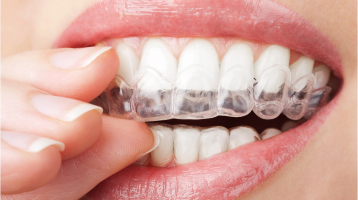Veneers vs. Crowns

When you are offered choices on a smile upgrade, the debate around veneers vs crowns often comes up. These two treatments cover damaged or discolored teeth but work in different ways. You may feel unsure which option fits your needs. This post breaks down how each treatment works and what you can expect.
How Veneers Work
A veneer is a thin shell bonded to the front of a tooth. It hides chips, stains, and small gaps in teeth you see when you smile. The shell uses a layer of tooth‑colored material that matches your natural shade. Your dentist removes just a bit of enamel, so the shell sits flush with your other teeth. Once in place, the veneer looks and feels like part of the tooth.
How Crowns Work
A crown slips over the entire visible part of a tooth like a helmet. It restores shape and strength when a tooth has deep cracks or a large filling. The dentist trims the tooth down so the crown fits snugly. Crowns can be made from porcelain, metal, or a mix of both. They handle biting pressure and protect the tooth under the surface from further damage.
Comparing Strength and Coverage
Crowns cover every side of the tooth above the gum line and offer full protection. They work well when a tooth faces heavy chewing forces. Veneers cover only the front and leave the back and sides of the tooth intact. They work best on teeth that need a cosmetic touch rather than full support. If you grind your teeth at night, a crown may stand up to that stress better than a thin shell.
Longevity and Maintenance
Both treatments last many years with daily brushing and flossing. A veneer can last over a decade if you avoid biting hard items like ice. A crown may last even longer under normal wear. You need to care for both just like a regular tooth by brushing twice a day and visiting your dentist twice a year. If a veneer or crown ever chips, a quick visit can fix it before more harm occurs.
Appearance and Feel
Modern materials give both dental solutions a natural look that blends with the surrounding teeth. Porcelain absorbs light much like real enamel, so a crown can vanish among your natural teeth. Veneers use the same principle and tend to be very thin, so they hardly change how your tooth feels when you bite. After a brief adjustment period, you may even forget which teeth have had work done on them.
Choosing the Right Option
Your situation influences the best option. If your main goal is cosmetic, hiding stains or slight shape flaws, a veneer may fit your plans. If a tooth has seen heavy decay or needs a big filling replaced, a crown gives more strength and peace of mind. A careful exam with dental x‑rays helps your dentist spot damage below the surface and recommend the right fix.
What to Expect in Your Appointment
We at Edgemont Dental Arts use state‑of‑the‑art scanners to take a digital impression instead of messy putty. This approach lets you see how your new tooth will look before any work begins. In most cases, we craft crowns and veneers in our on‑site lab and place them in the same day. A single visit can leave you with a restored tooth that feels secure and fits according to your bite.
Cost Considerations
Both veneers and crowns involve lab work and skilled placement, so both come with at a price. A single crown may cost more than a single veneer because of the added material and extra steps to shape the tooth. You can consider insurance but take note that different plans vary in coverage for cosmetic treatments. Your dentist can share options for financing so you can move forward without delay.
If you are ready to learn which option suits your smile goals, contact our team today. Call (973) 744‑9330 to schedule a consultation and take the first step toward a confident new look.
